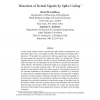Free Online Productivity Tools
i2Speak
i2Symbol
i2OCR
iTex2Img
iWeb2Print
iWeb2Shot
i2Type
iPdf2Split
iPdf2Merge
i2Bopomofo
i2Arabic
i2Style
i2Image
i2PDF
iLatex2Rtf
Sci2ools
NECO
2007
2007
Distortion of Neural Signals by Spike Coding
Analog neural signals must be converted into spike trains for transmission over electrically leaky axons. This spike encoding and subsequent decoding leads to distortion. We quantify this distortion by deriving approximate expressions for the mean square error between the inputs and outputs of a spiking link. We use integrate-and-fire and Poisson encoders to convert naturalistic stimuli into spike trains and spike count and interspike interval decoders to generate reconstructions of the stimulus. The distortion expressions enable us to compare these spike coding schemes over a large parameter space. We verify that the integrate-and-fire encoder is more effective than the Poisson encoder. The disparity between the two encoders diminishes as the stimulus coefficient of variation (CV) increases, at which point the variability attributed to the stimulus overwhelms the variability attributed to Poisson statistics. When the stimulus CV is small, the interspike interval decoder is superio...
Interval Decoder | NECO 2007 | Spike | Spike Count |
| Added | 27 Dec 2010 |
| Updated | 27 Dec 2010 |
| Type | Journal |
| Year | 2007 |
| Where | NECO |
| Authors | David H. Goldberg, Andreas G. Andreou |
Comments (0)

